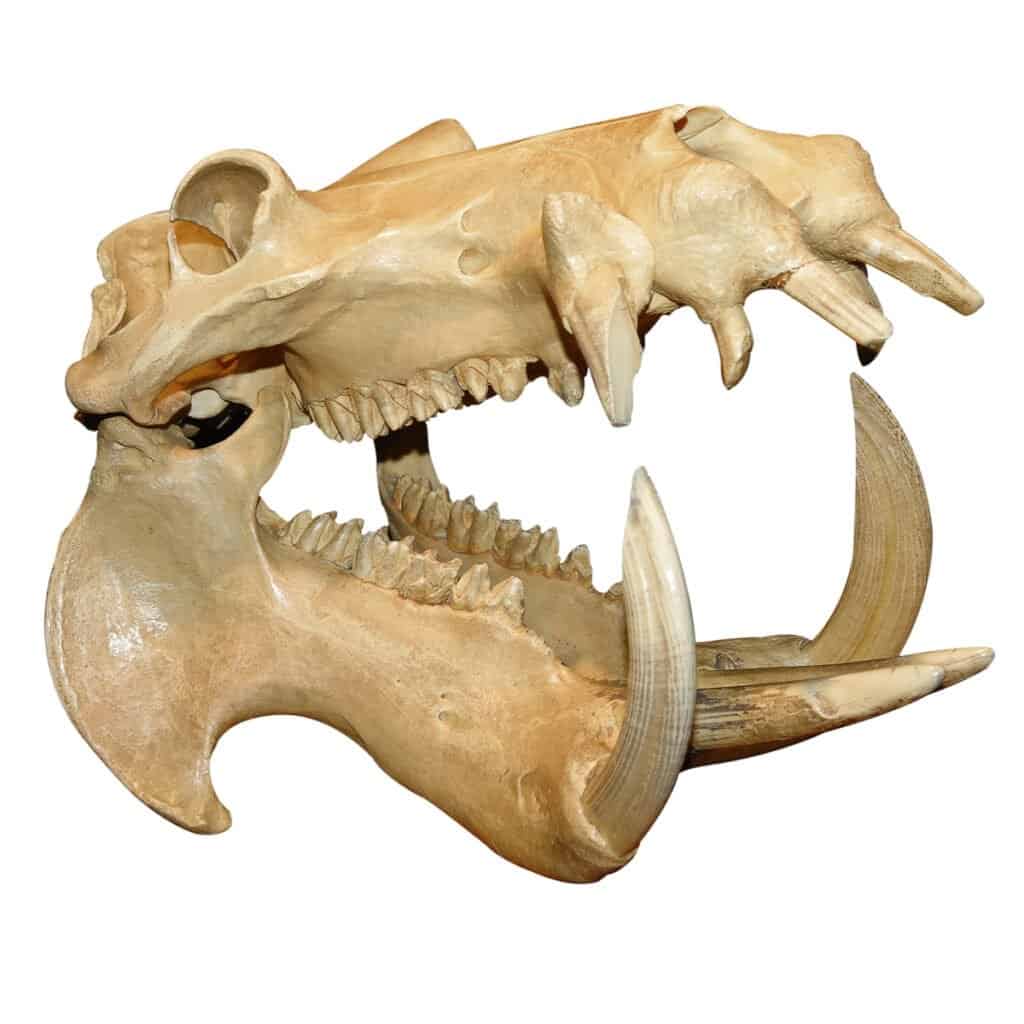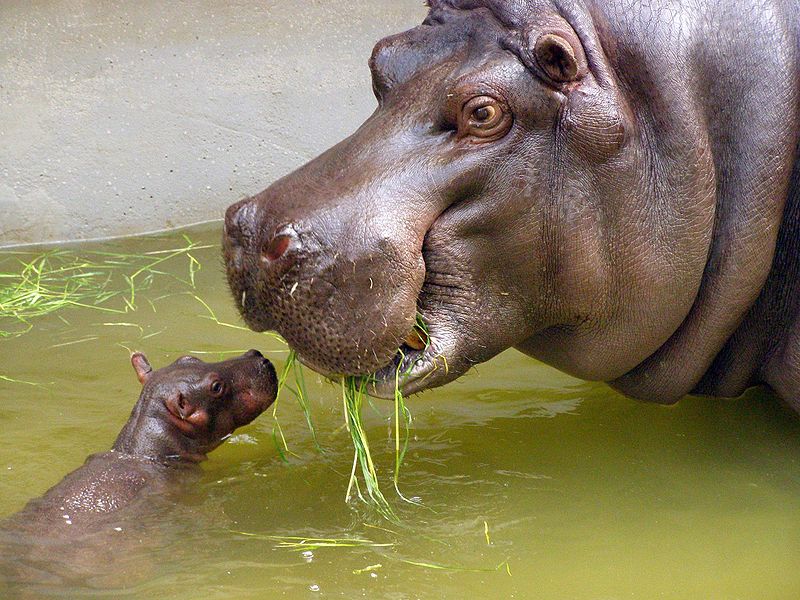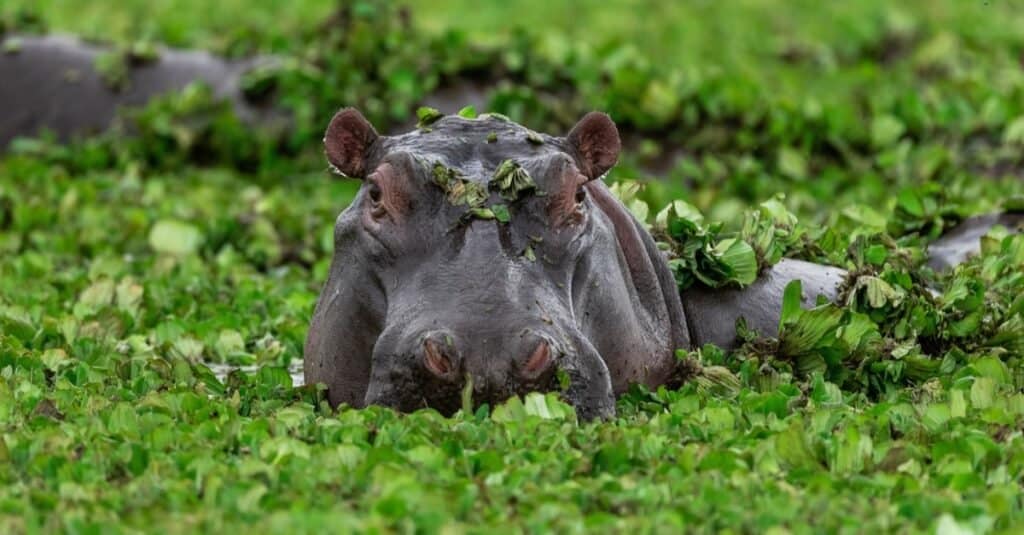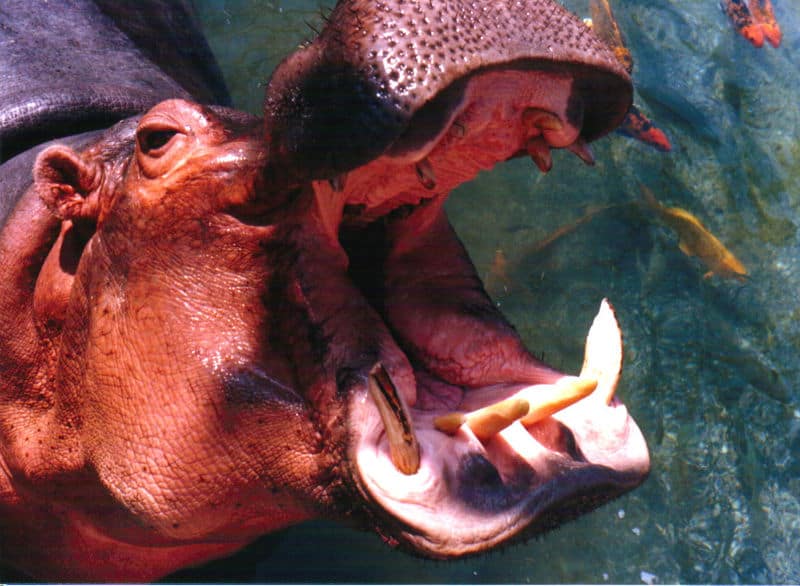Hippopotamuses are some of the largest creatures on earth and the deadliest animals in Africa. These territorial behemoths may look cute and cuddly (especially as babies), but they have an unrivaled ability to cut people in half with their teeth and jaws. Their name comes from the Greek translation of “river horse,” and the description seems to be accurate. One of the defining characteristics of these animals is their massive mouths and teeth. Let’s take a look at them and learn about hippo skulls: what it looks like and it’s size.
What does a hippo skull look like?

Hippo skulls are clearly designed for animals that live in water. Their ears, nose, and eyes are all situated on top of their skulls to make complete submersion in water easier.
©VINCENT GIORDANO PHOTO/Shutterstock.com
Hippopotamus was once present across all sub-Saharan Africa but now are relegated to isolated regions, mostly across East Africa. They are large animals and resemble a cow in some features. They are, however, built for the water. If you ever find yourself staring a hippo in the mouth, chances are it’s already too late.
Hippo skulls are large with eye sockets high on the skull and rounded features. Additionally, their ears and nostrils are upward-facing or placed in a way that allows them to remain underwater for long periods of time. They have massive teeth that face outward in a menacing way.
Their jaws are large and can open large enough to fit a toddler standing up. The jaw is powered by a large masseter muscle (used for chewing and to open and close the mouth), allowing them to have a truly massive bite force. Their mouths can open to 180 degrees and can be seen at full extension when yawning. The ability to open so wide is allowed by a rear-located jaw and a folding orbicularis oris muscle that can fold open and closed when needed.
Their teeth include their molars, but any animals who get too close are likely to only see their canines and incisors. Their canines are the ones to the left and right of the mouth, and their incisors are located in the middle (where we would consider our two front teeth to be.
How big is a hippo skull?

Hippo jaws can stretch to 4 feet wide when open.
©Frank Wouters, CC BY 2.0, via Wikimedia Commons – License
Hippo skulls are massive, reflecting the animal that they came from. A standard specimen is 2 ft 3 inches long, 1 ft 6 inches wide, and 1 ft 8 inches high. While there isn’t any specific information on the exact weight of a hippo head, we can assume it’s a few hundred pounds fully fleshed. A full-weight hippo, for reference, is 3,310 lbs on average.
When it comes to their teeth, they are just as massive. Their molars are used for grinding and don’t have anything special around their size. It’s in their front teeth that things get big. Their incisors (the teeth in the front middle) can grow to 1 foot 4 inches, making them over half as long as a human forearm. Their canines get larger, averaging 1 foot 8 inches. Lower teeth generally grow larger than the top teeth, especially in males.
How strong are hippo jaws?

Hippos have some of the strongest jaws in the animal kingdom, measuring 1,827 psi (10 times stronger than a human)!
©nataliatamkovich/Shutterstock.com
Strength is a given when it comes to hippos. Their bite force has been measured at 1,800 psi (in a mature female), which is ten times that of a human (but over a much, much, larger area). This gives hippos some of the strongest jaws in the entire animal kingdom.
There is a common misnomer that a hippo could “bite a croc in half,” but that isn’t really the full story. It is true that a hippo could kill a crocodile in a single bite (and have been recorded doing so), but it wouldn’t be as comic book-like as we would hope it would be. That being said, a single bite is enough to dispatch any predator without much effort on the hippos part. Lions, hyenas, and crocodiles all stay away from these beasts.
The two main muscles that give a hippo its strength are the masseter and digastric muscle. The digastric muscle loops up and connects behind the masseter, giving the hippo some extra strength by allowing the muscles to work together.
What makes hippo skulls unique?
There are a few things that make the hippo skull unique, especially from an evolutionary perspective.
First is the sensory placement. Their eyes are situated at the tops of their head, allowing them to submerge their body and still look out above the water. Since hippos need water to keep their skin hydrated, this allows them to spend most of their day submerged. Additionally, their ears are placed high enough that submersion keeps them from getting filled with water.
Their nostrils are lower on the skull but close up when they decide to completely submerge. Similar to a whale breaching, when a hippo comes up for air, it can open the nostrils, clear the water, and breathe without putting its head too far above the water.
Additionally, hippo teeth sharpen themselves over time. Their teeth are used for fighting between one another, not for feeding or digging. The sharp teeth are constantly growing and are formidable weapons evolved as a way to fight for feeding grounds and females.
When it comes to eating, hippos have bony lips that they can use to grab vegetation. They need to eat around 100 lbs of food a day, making foraging and eating extremely important. Their horny lips can grab and rip vegetation from the riverbanks and bottoms without much effort.
Do hippos have tusks?

Hippos have ivory tusks that come from their incisor and canine teeth.
Hippos do have tusks, but they aren’t the same caliber as an elephant. They more closely resemble that of a boar or warthog, allowing them to fight and gain access to territory or females. Generally, tusks are considered to be modified teeth that provide some type of evolutionary advantage. In hippos, their incisors and canines have evolved to grow outward as weapons.
Do hippo skulls have ivory?
Hippo tusks are made of hard ivory, denser than even that of an elephant. While some do seek out hippo ivory, it is generally considered inferior quality to that of elephants because of its yellow color. It is significantly harder to carve and was historically used as dentures and tooth replacements. In fact, George Washington was famed for having hippo ivory in his denture set when he began losing his teeth.
The photo featured at the top of this post is © Karel Bartik/Shutterstock.com
Thank you for reading! Have some feedback for us? Contact the AZ Animals editorial team.






